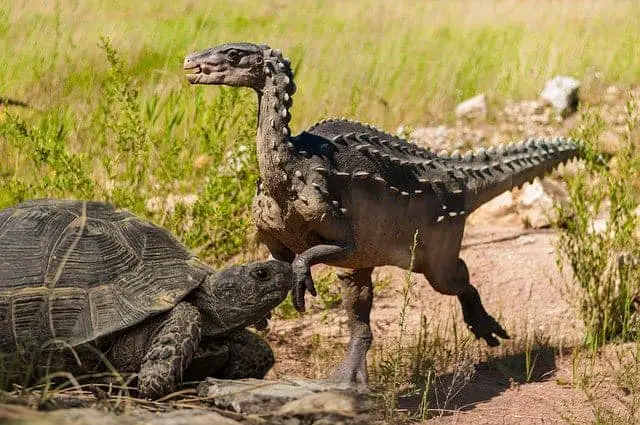
Although they certainly look prehistoric, tortoises are not dinosaurs. In fact no creature alive today fully matches the criteria required to be described as such.
What is interesting however is that tortoises would certainly have coexisted with dinosaurs, and in some cases they even predate the existence of dinosaurs.

This also means tortoises were able to survive the disastrous event or events that ultimately caused dinosaurs to go extinct.
So What Makes a Dinosaur a Dinosaur?
In short this all comes down to genetics. Whilst there are certainly similarities between tortoises and dinosaurs, for example whilst both are egg laying reptiles, many dinosaurs are more closely genetically related to modern birds than reptiles.
For me the most critical difference is that dinosaurs were believed to be fast moving creatures, with a high metallic rate, and were possibly even warm blooded animals, leading to a faster growth rate more akin to mammals. This is a fundamental difference to tortoises who are very much governed by their cold blooded metabolism, and that grow at a much slower rate than mammals.
If you struggle to see such differences as significant, then consider the fact that even other creatures that died out with the dinosaurs, such as pterosaurs (often thought of as ‘flying dinosaurs’) and plesiosaurs (aquatic dinosaurs akin to the Loch Ness Monster) are also largely genetically different to dinosaurs.
There Are Certainly Genetic Similarities Between Tortoises and Dinosaurs
Of course just because birds (who of course aren’t even reptiles) are more closely related to dinosaurs than other modern creatures, doesn’t mean there isn’t any common ancestry at all between tortoises and dinosaurs.
In recent years scientists have developed ever more sophisticated techniques for determining the genetic origins of turtles and tortoises, ultimately showing that along with other reptiles and birds, tortoises do indeed share some genetic ancestry with dinosaurs. Check out this article for more information on that.
When you picture the slow lumbering movements of herbivorous dinosaurs such as diplodocus a triceratops, it’s difficult to believe there can’t be some sort of connection between them and tortoises, particularly the giant tortoises of the Galapagos isnlands.
So How Did Tortoises Outlive Dinosaurs?
When you’re discussing the history of the natural world some 65 to 200 million years ago it can be difficult to reach unanimous conclusions about how exactly animals behaved and looked. However knowing that tortoises and turtles have existed since this point in time right up to the present day means there must be something about their biology that has been particularly enduring.
If we first consider how tortoises were able to exist at the same time as dinosaurs, it’s fairly safe to assume that their physiology and habits weren’t in conflict with those of many of the larger and formidable dinosaurs.
Given that the ‘design’ of tortoises remains unchanged after several hundred million years suggests that the shell has been a successful form of protection for tortoises, despite their slow movements leaving them vulnerable to attack from predators.
As for how tortoises were able to survive the cataclysmic event that ultimately saw the dinosaurs go the way of the dodo… albeit many millions of years prior to the ill fated flightless bird, there are several theories on this.

The general consensus is that the dinosaurs were rendered extinct by the impact of a large meteor, believed to have struck at the tip of what is today known as Mexico’s Yucatán Peninsula, resulting in the massive ‘Chicxulub Crater’ that is buried under the site today.
In the aftermath of this event it is believed the earth would have been plunged into darkness as a result of burning debris clouding the atmosphere and causing temperatures to drop drastically. Many animals including dinosaurs would have died out in the ensuing deep freeze as food sources, including the plant life for herbivorous dinosaurs, would have been destroyed.
Now many tortoises have a secret weapon when it comes to enduring long periods of famine; the ability to hibernate. It’s highly likely that tortoises, with their slow moving metabolisms and ability to hibernate for many months on end, surviving in a semi-concious state that uses very few calories, were able to ‘wait out’ the worst of this post apocalyptic aftermath and come out the other side to tell the tale.
Many dinosaurs were large imposing creatures, but in a world depleted of food almost overnight, this would have been absolutely disastrous, which just goes to show that power and size isn’t always everything!

